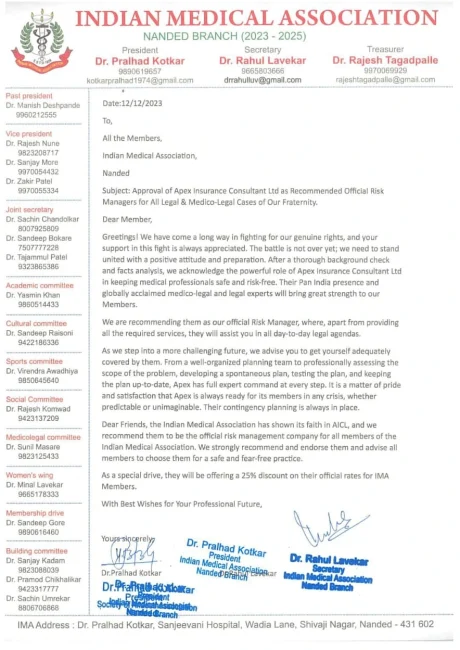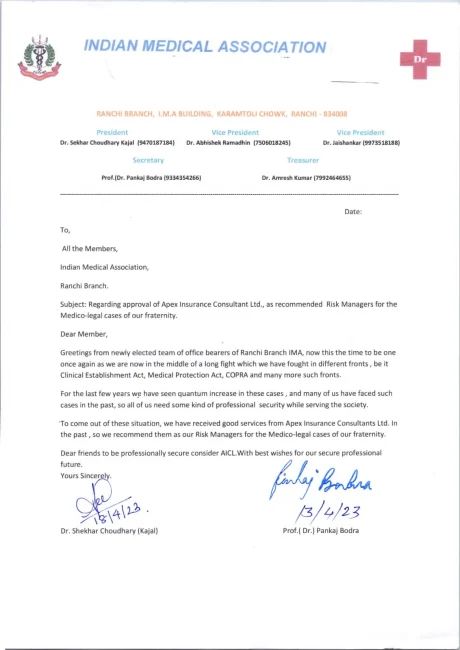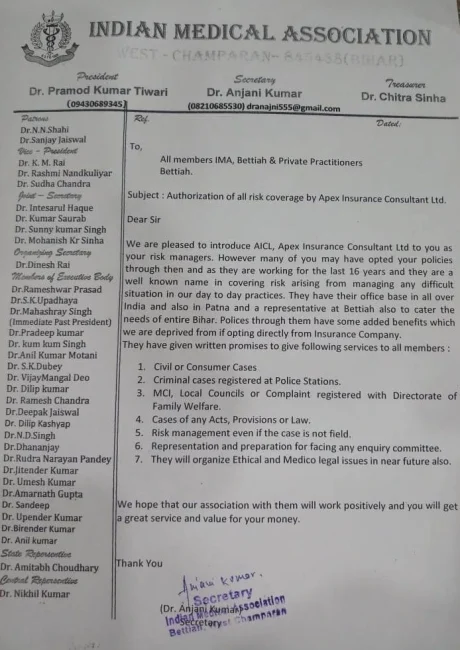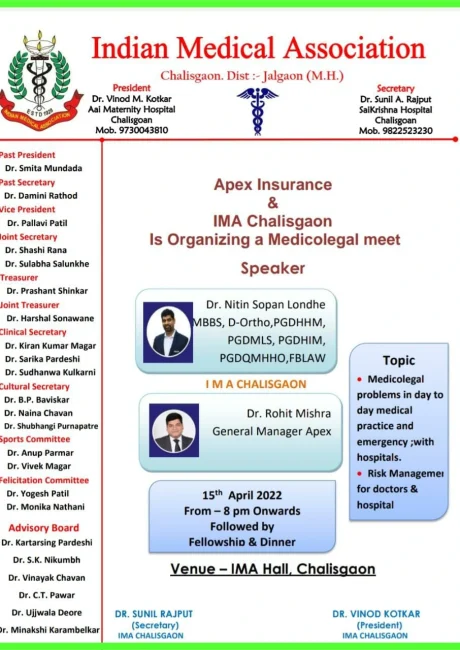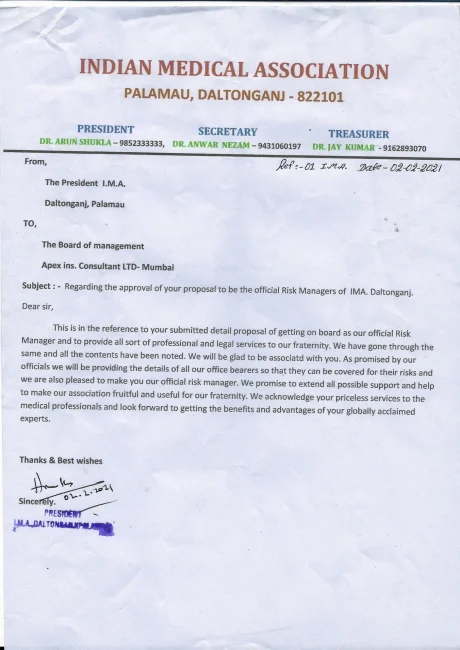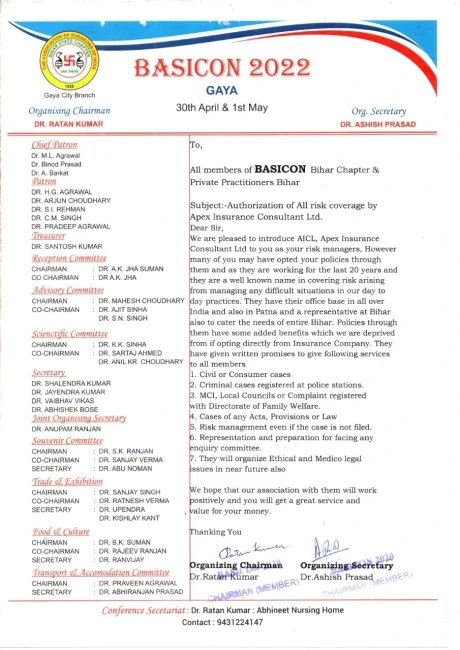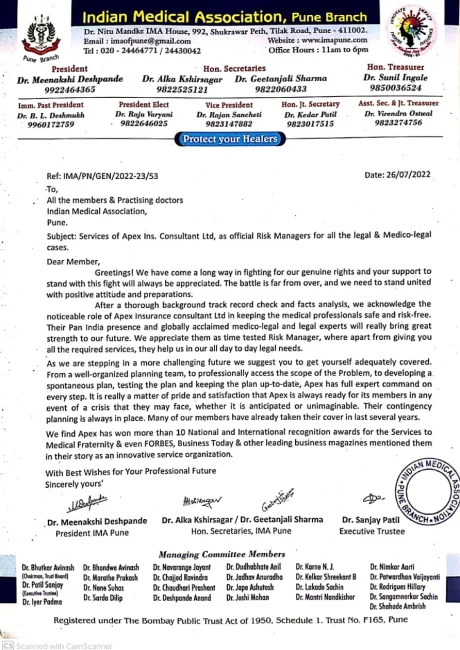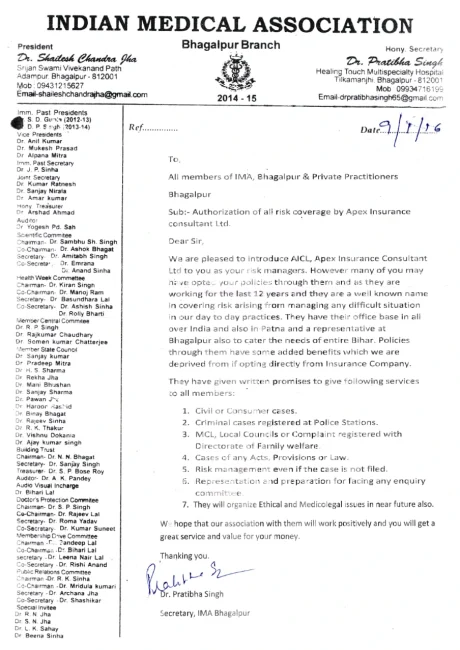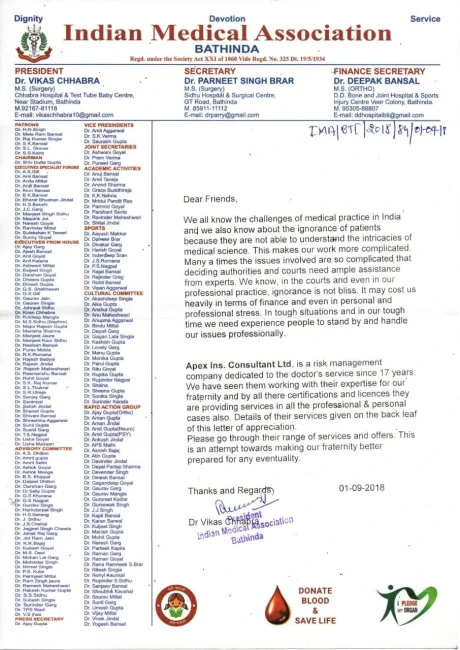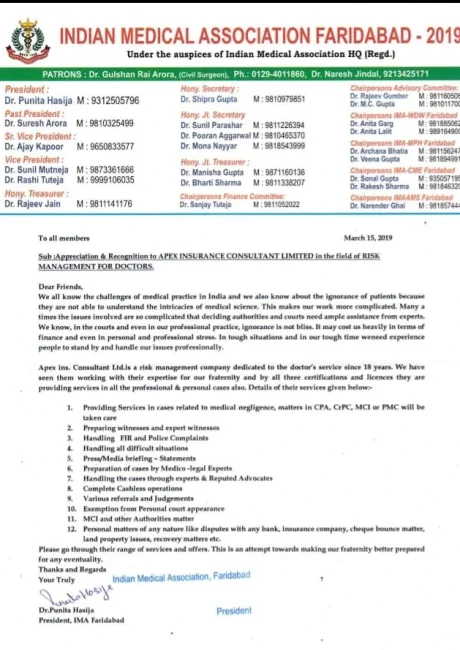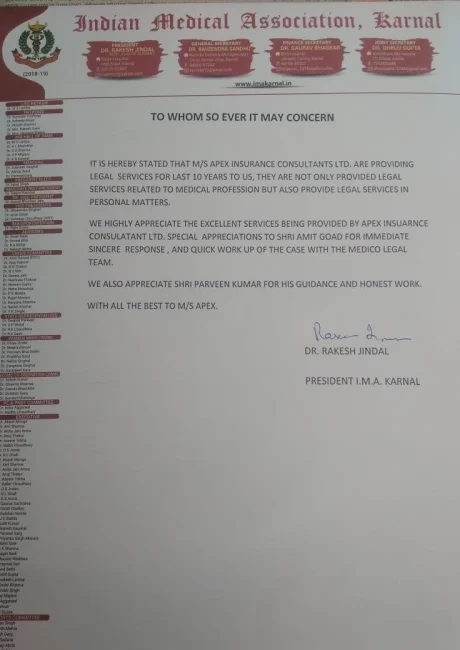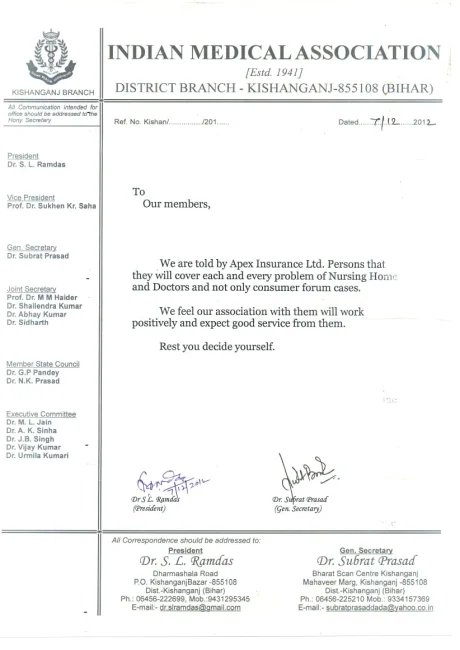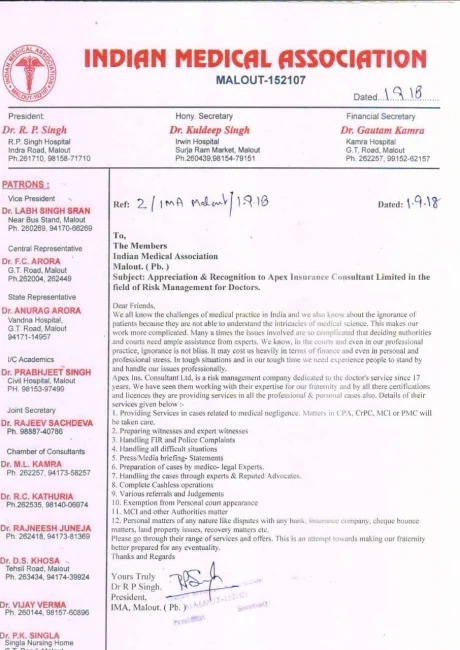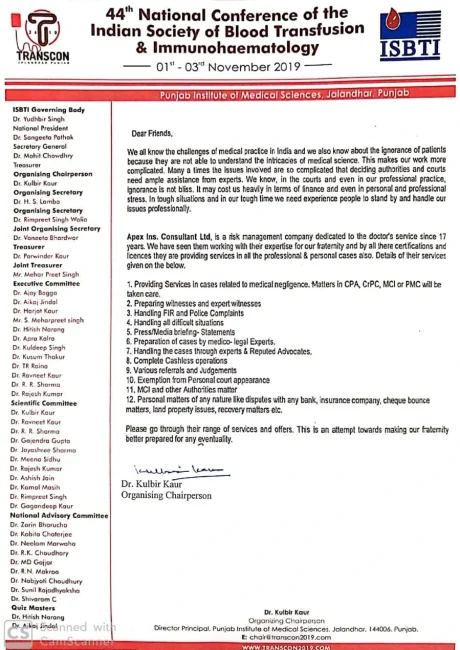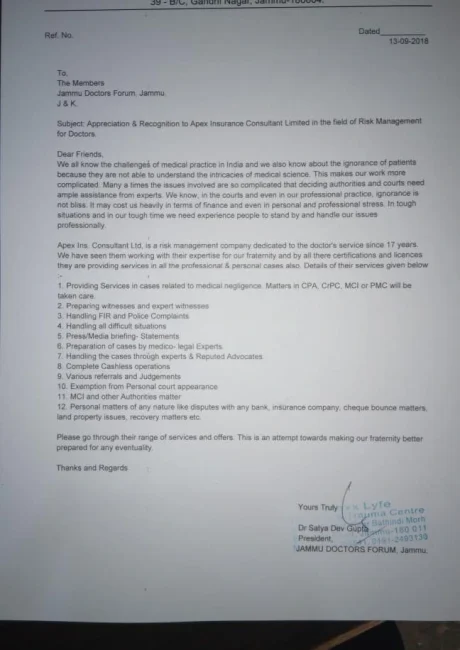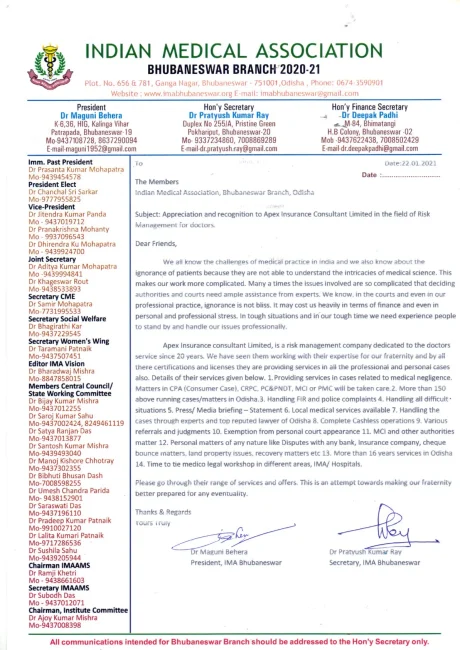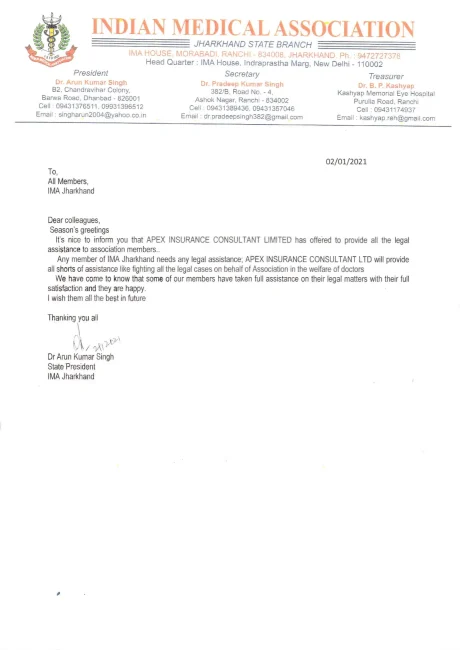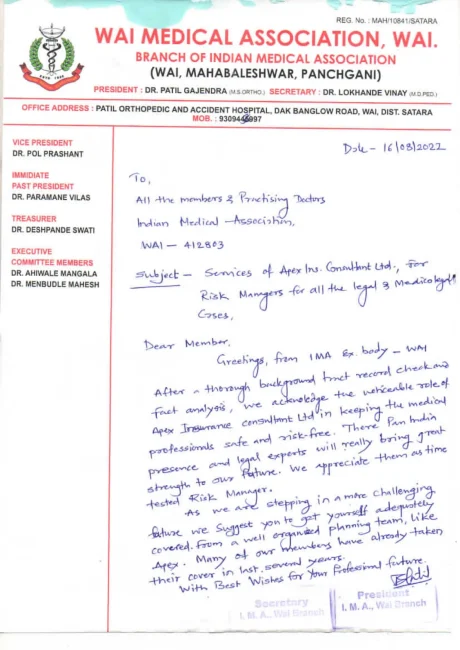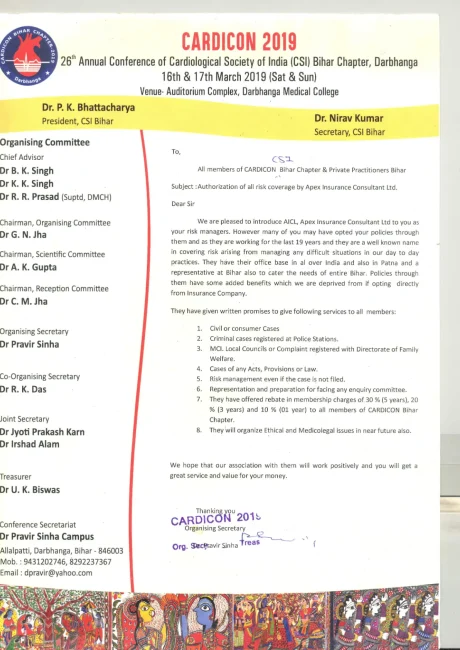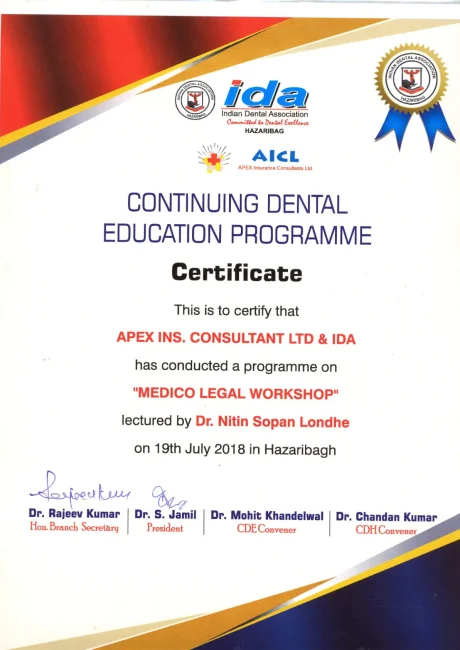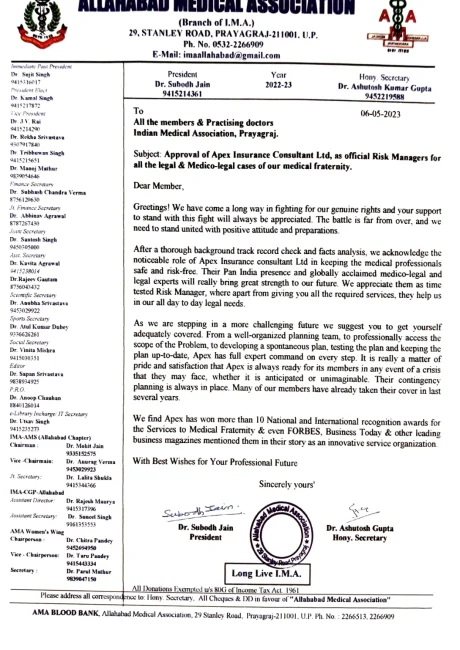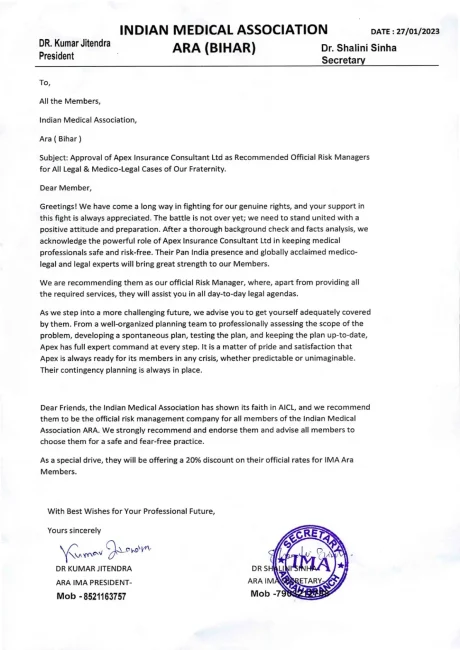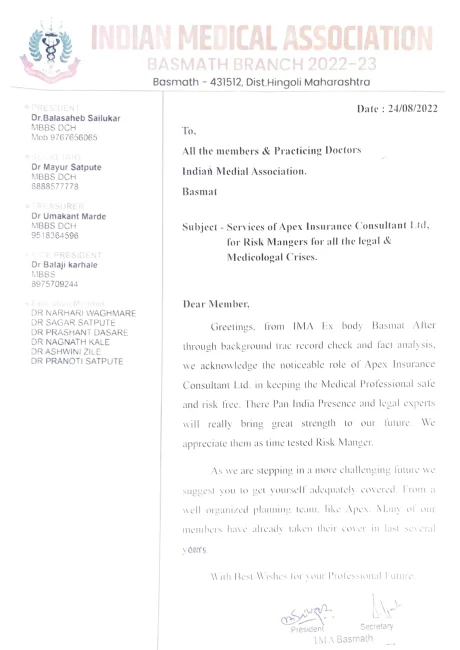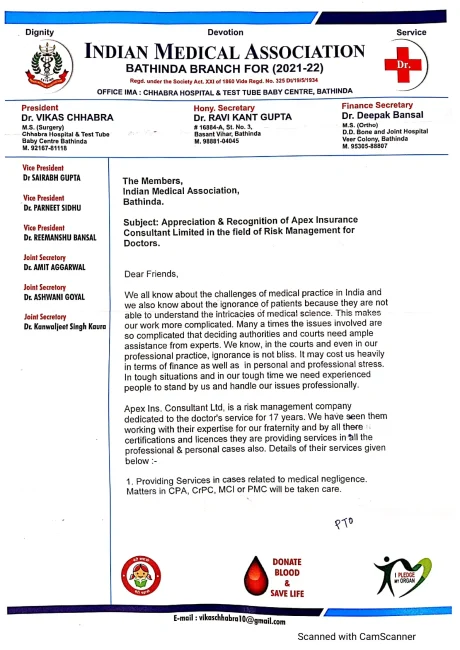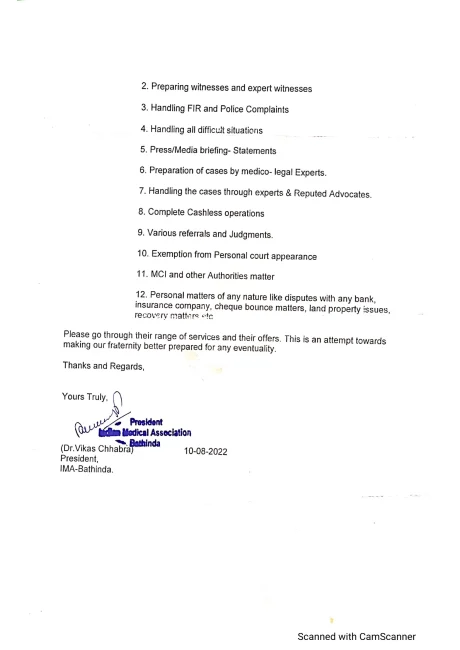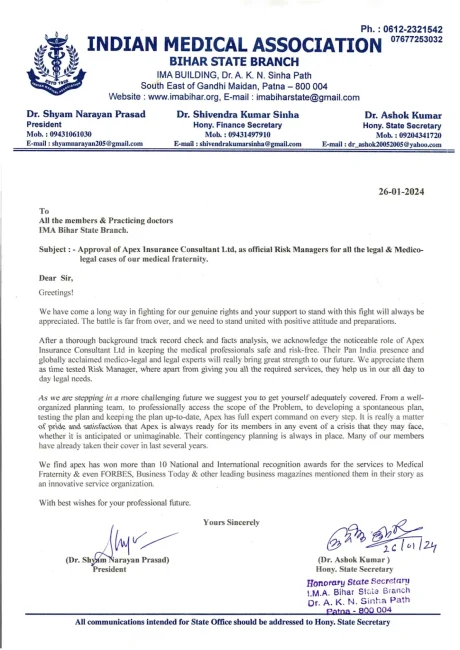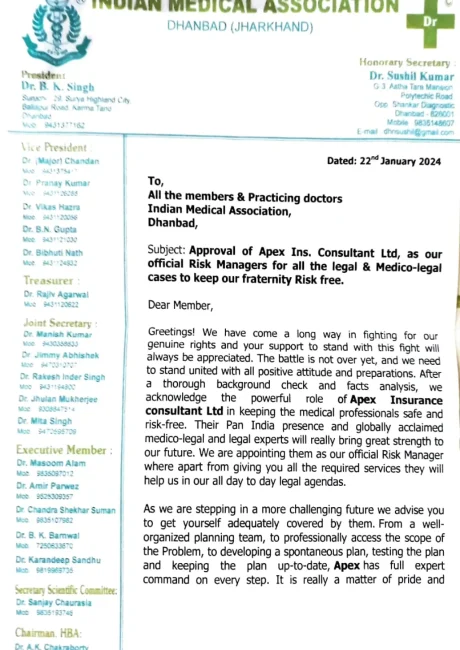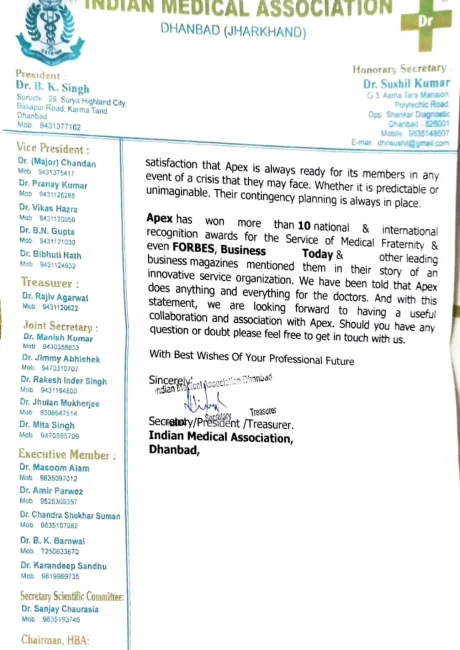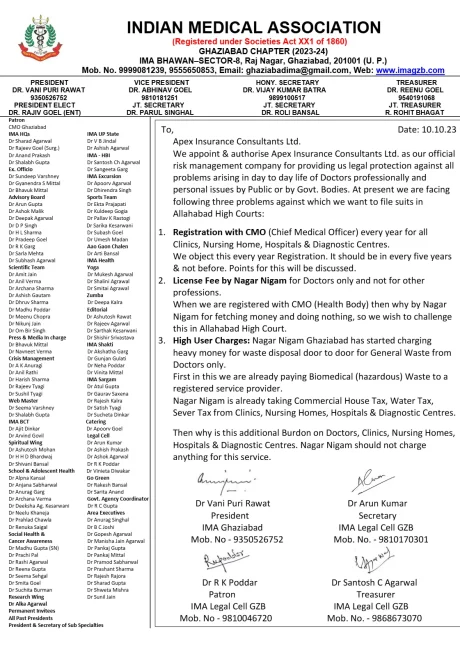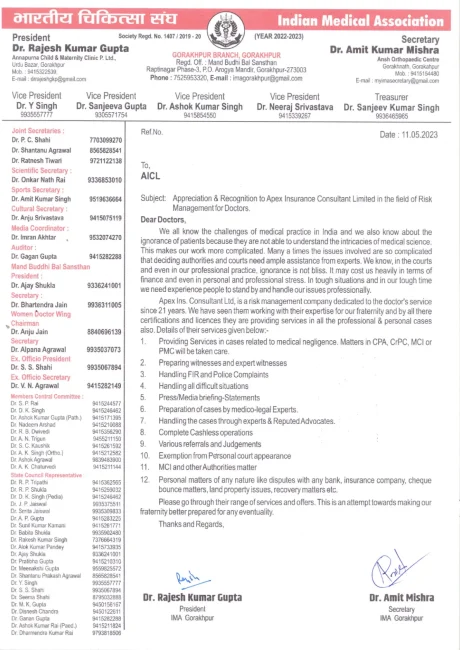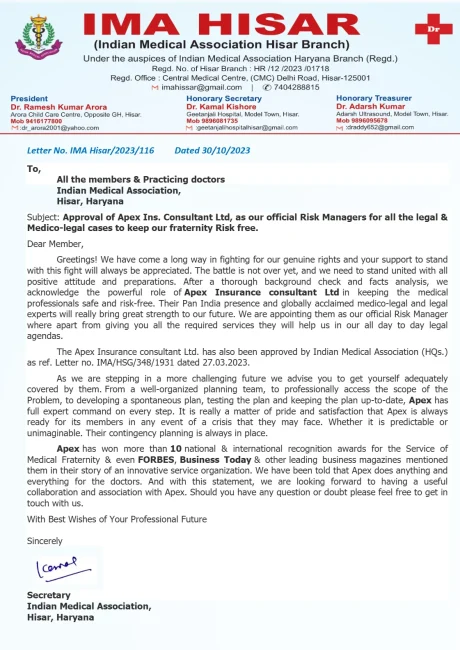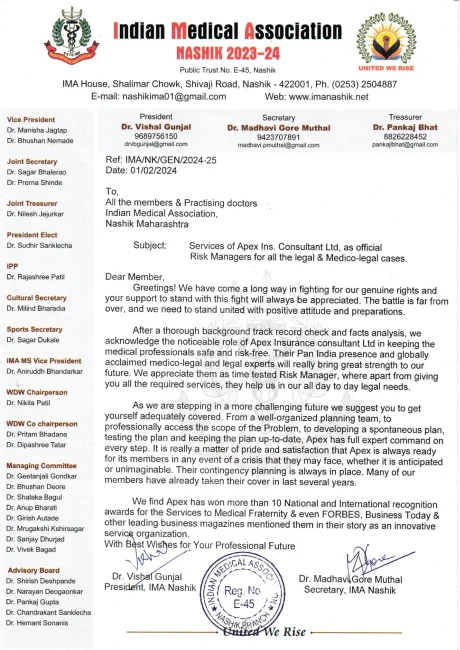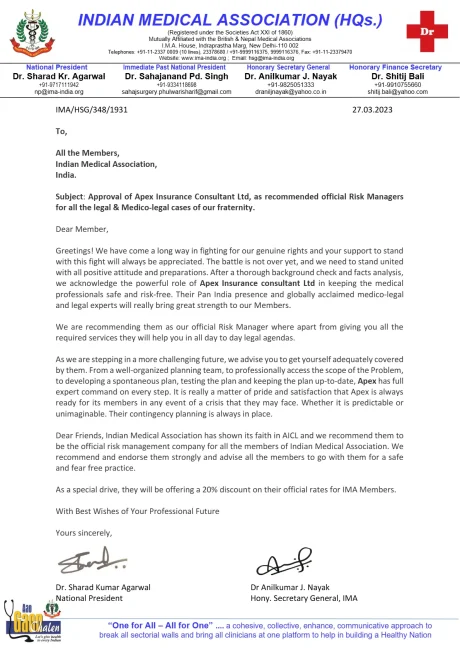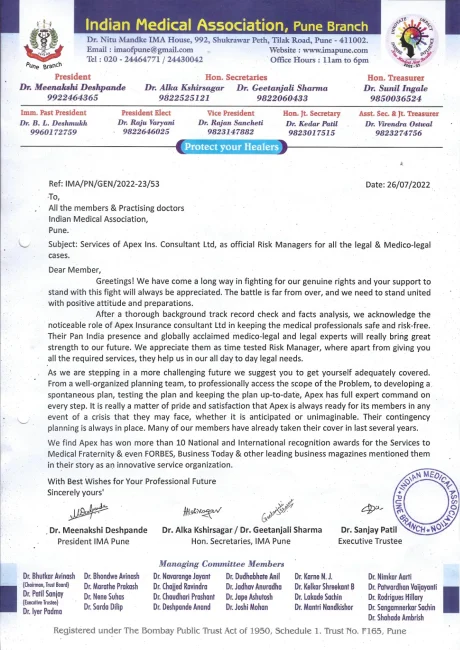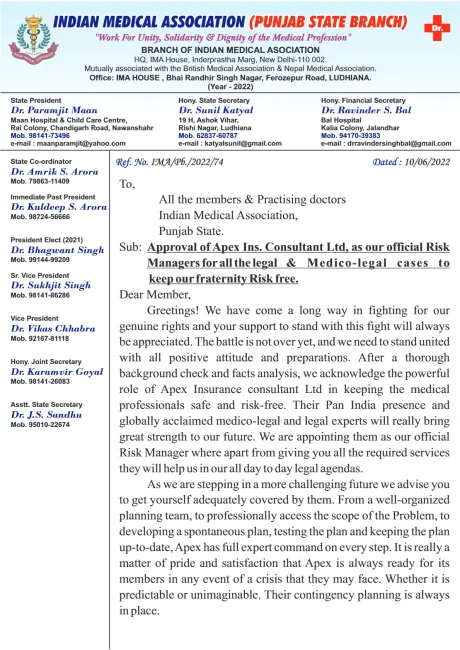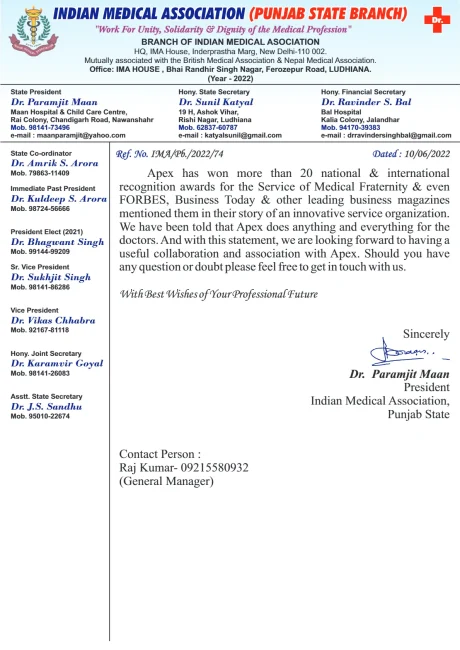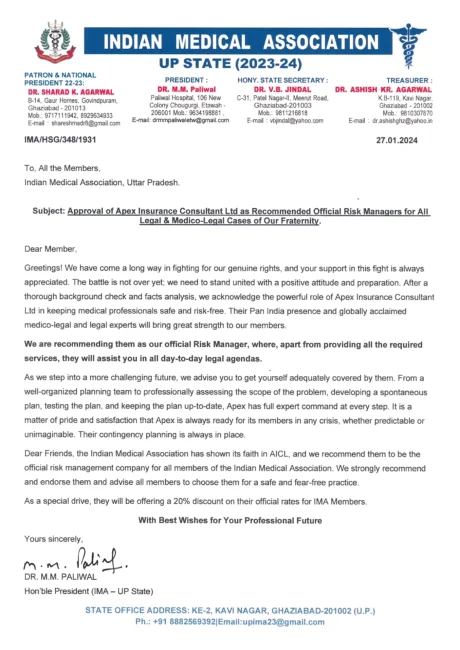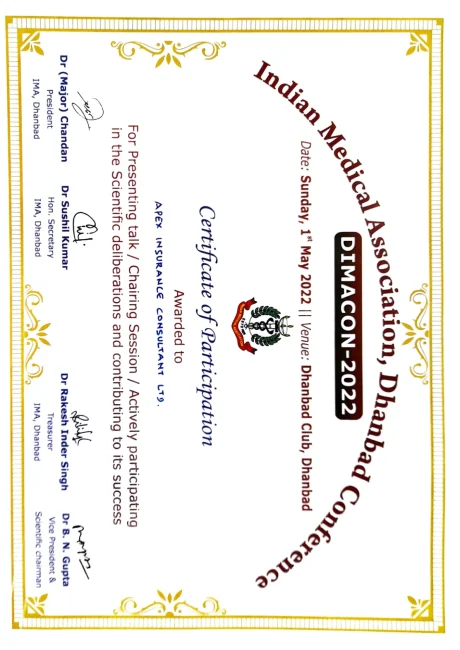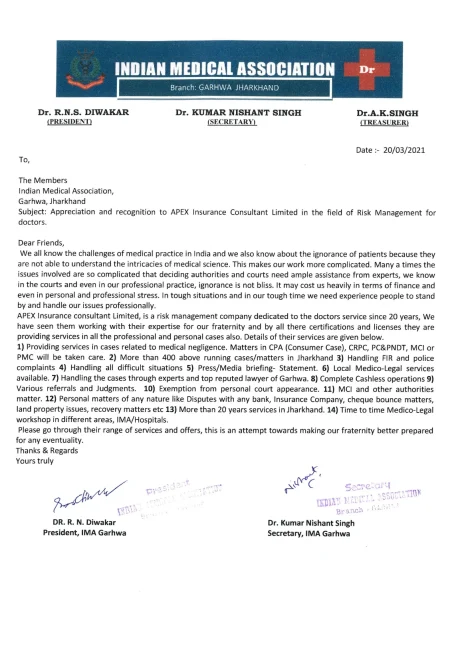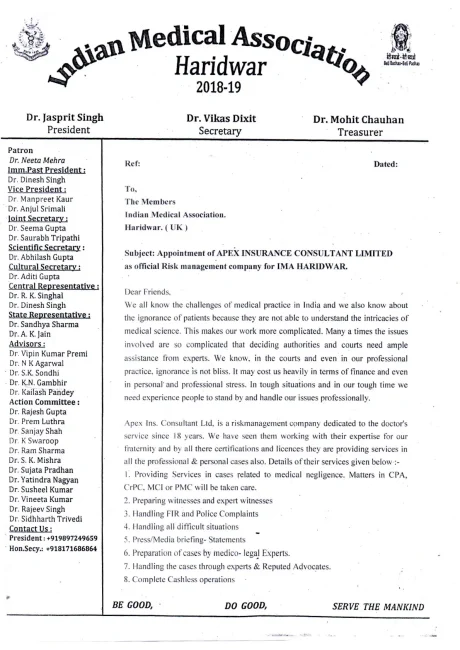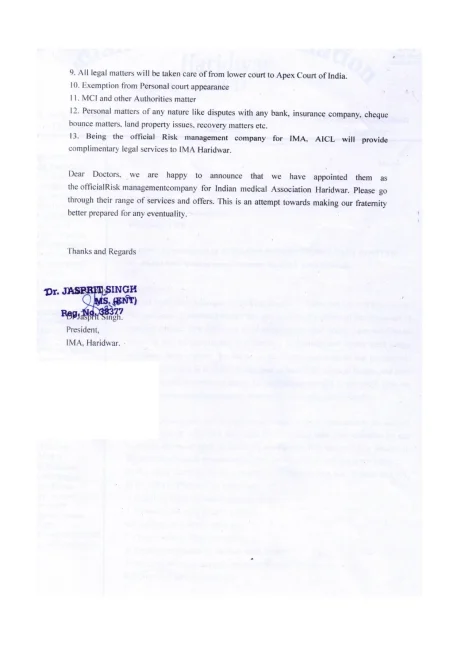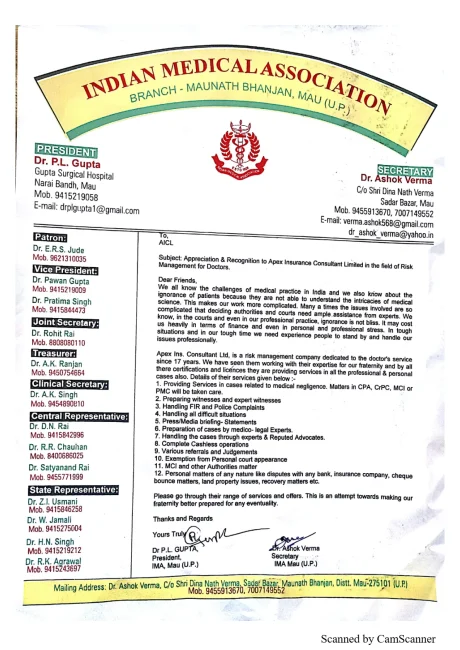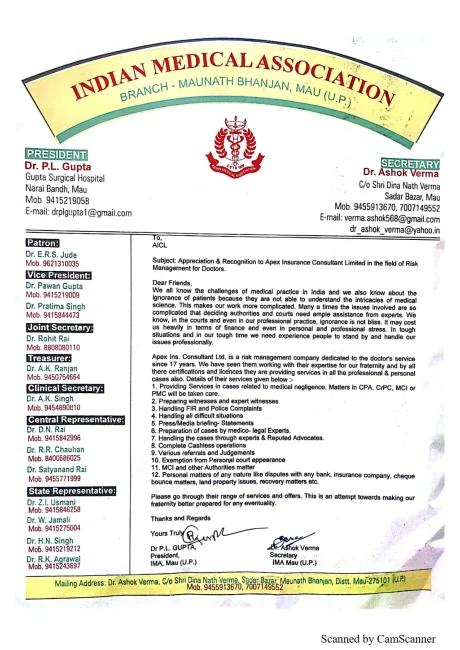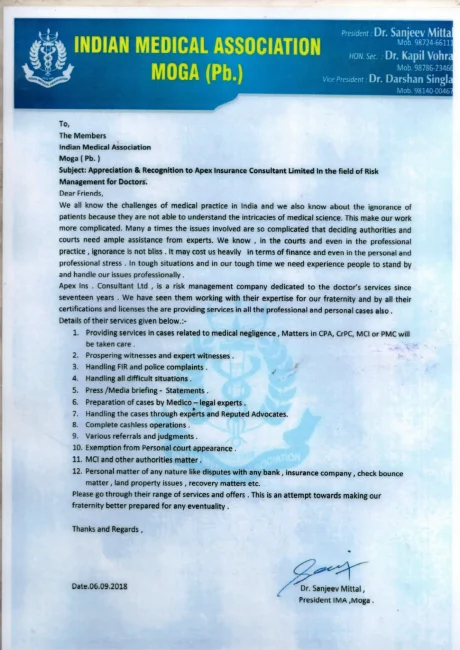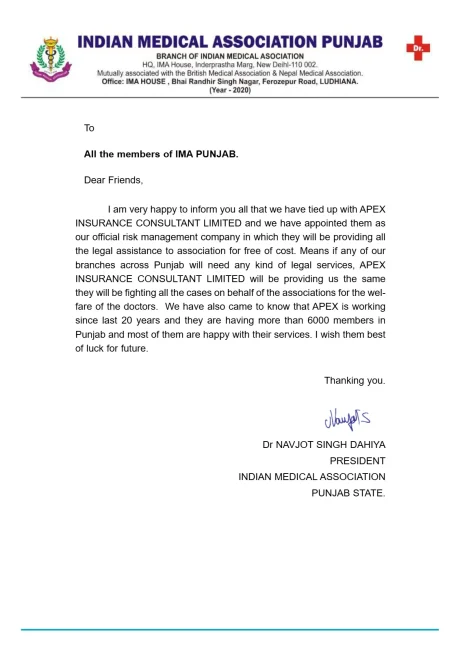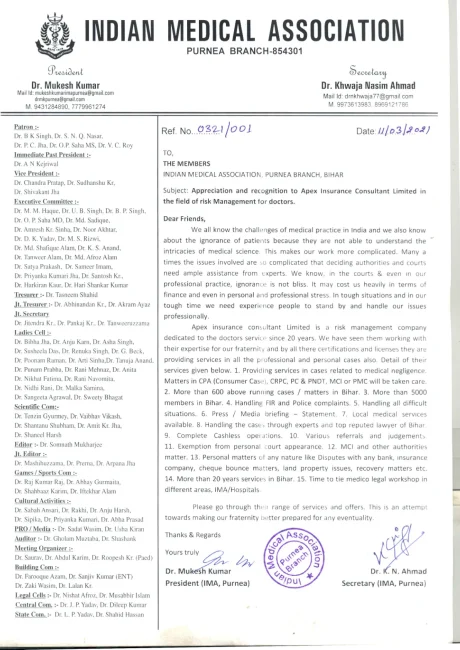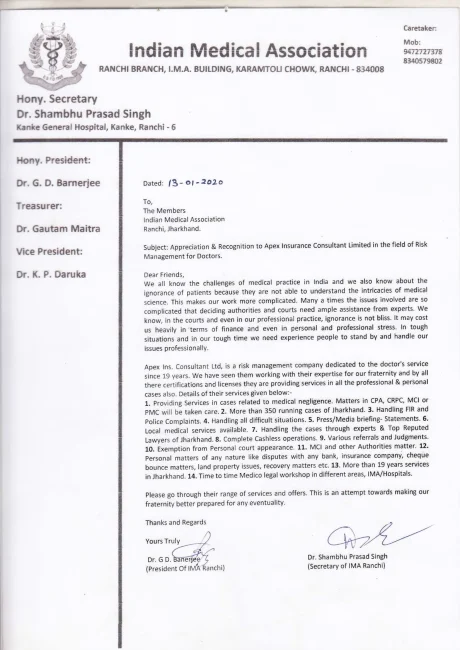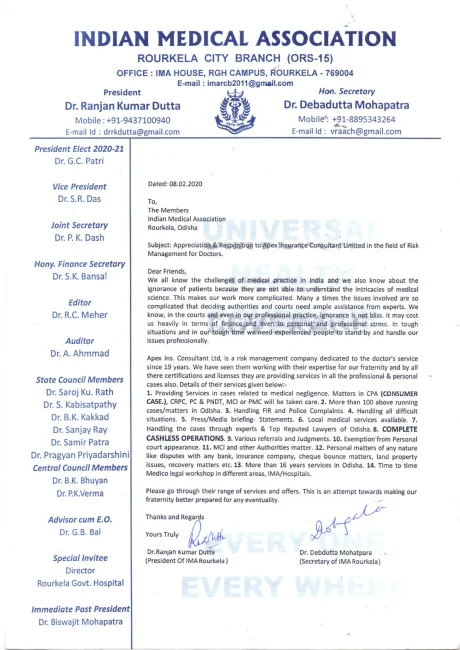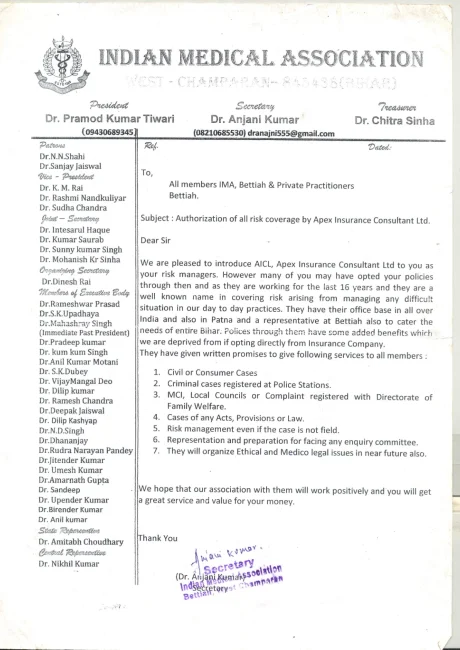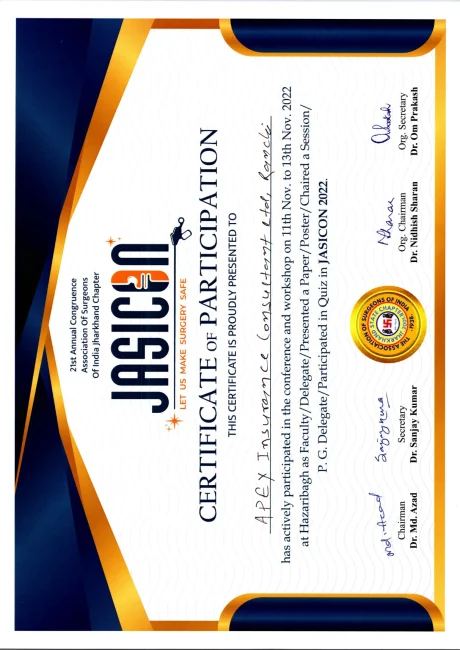By, Dr Mahesh Baldwa, Dr Varsha Baldwa, Dr Namita Padvi, Dr Sushila Baldwa
Introduction
This write up is done with an aim to pave way to make a new statute or law or legislate “No-fault” medical compensation law and indemnity insurance to cover for medical negligence, mishap, accident under law of tort.
Shortcoming of existing law
There are shortcomings of existing law of tort related to medical negligence litigations are discussed and the reason for its replacement for patients. It will promote amongst Medical professional’s transparency in reporting errors, mishaps, accidents so future corrective actions and learning from mistake will be possible. Under the current system trial under law of tort related to medical negligence is deterrent to reporting errors, mishaps, accidents. It also promotes blame game and shame. The day litigation starts doctors feel heat of punishment, which may or may not happen. Medical professionals laugh at colleagues who are caught in litigation but wish that let this not happen to them during their practice. Apart from financial and time consuming repercussion of litigation, litigations are emotionally and psychologically exhausting. The judicial discretion keeps stifling the standard of care from case to case basis and its application and final outcome. It appears that one is speculating rather than litigating.
Studies on results of doctor patient litigation
From India – In one study from India revealed that it is easier to prove allegations of medical negligence against Surgery and Allied Specialty as compared to Medicine and Allied Specialty. Chances of proof of allegations of medical negligence against Diagnostic Specialty (Radiology, Pathology, Biochemistry, etc.) are highest at 50% cases, followed by Surgery & Allied Specialty with 34.48%, Dentistry with 25% and with least chances of prove in Medicine & Allied Specialty with only 18.18% respectively.
From USA – But even when a case is dismissed, the road is typically long for both doctors and the patients suing. how long malpractice claims take to resolve, or what proportion of them actually end in a payment to patients is studied. For this study, they looked at more than 10,000 malpractice claims against U.S. doctors closed between 2002 and 2005. They found that of all claims, about 55 percent resulted in an actual lawsuit. Of those litigated claims, more than half were dismissed by the court. And out of the rest, most were resolved before a verdict; less than five percent ended up being decided by a trial verdict. When there was a verdict, it went in favor of the doctor 80 percent of the time.
For doctors, the outcomes of claims varied by specialty – For example, internists were among the most likely to have cases against them dismissed in court. Pathologists and pediatricians were least likely: about 36 percent of cases against pathologists, and a little over 40 percent against pediatricians, were dismissed. Pathologists study lab test samples and are key in diagnosing diseases. If they seem to have missed something, there is going to be more scrutiny. The same may be true in cases against pediatricians because a child is involved.
Why litigations are tiring both for patients and doctors
In a study on Malpractice claims against U.S. doctors are often dismissed, and when they go to trial, the verdict is usually in the doctor’s favor. “Most claims go in favor of the physician, and they take a long time to resolve,” What is killing was the length of time cases took to resolve — even when they were dismissed. “It is hard on everyone- patient as well as doctors” On average, lawsuits dismissed against doctors in court took more than 20 months, and some resolved out of the court before a verdict took over 28 months. Cases that went all the way to a trial verdict typically lasted a few years: 39 months, on average, when it went in favor of the doctor, and close to 44 months when the patient won.
Litigations between doctor and patients based on law of tort as basis medical negligence are
- Long drawn out in time frame, even in consumer courts both for patients as well as doctors
- Costliest even in consumer courts both for patients as well as doctors
- It appears as if instead of litigation they are in speculation
Usual difficulties for patient party
- Finding a Qualified Medical Malpractice Lawyer
- Convincing the Judges that the Doctor Was Negligent at admission stage of case
- Proving the Doctor’s Negligence
- Complicated Medical Evidence
- Necessity of Medical Experts
- High Cost of Litigation
Usual difficulties for doctors
- disruption and distress of a trial to a doctor’s practice and family life
- Paucity of time
- Monetarily and psychologically Expensive
- long-term stress due to psychic burden takes its toll in physical health
- Not able to understand shifting, stifling, wobbling and variable legal algorithm and paradigm
- Real consent, medical records are impeached. Tacit consent has no place.
- The average litigation goes on from 3 to 5 year or more.
- Emotionally it’s consuming and exhausting.
- The allegations made are intensely personal and derogatory.
- Winning is better than losing, because it just looks a Pyrrhic victory even after win
- All this may force them to settle out of court
Proposal of “No Fault” medical compensation law
It is always patients who suffer death, disability, disfigurement due to alleged medical negligence. Though all death, disability, disfigurement is not due to alleged medical negligence but most of the times, it is patients who suffer from preventable medical error may not indulge in to litigation. Patient party suffers in silence. Hence for all who receive medical treatment, whether they allege death, disability, disfigurement due to medical treatment or not should receive “No-fault” claim from insurance companies. This is a social benefit, which they can choose relinquishing tort remedy under alleged medical negligence law. This will also lead to proactive reporting and learning from committed error committed by doctors. “No fault” medical compensation law should be promulgated to replace medical negligence under law of tort.
Doctors need identification of medical error and accidents as first step to learn and prevent
In 2016, Medical errors are found to be under-recognized cause of death. 10 percent of all U.S.A. deaths are now due to medical error. Medical error is the third highest cause of death in the U.S.A. “To err is human” so are medical errors. According to the CDC, in 2013, 611,105 people died of heart disease, 584,881 died of cancer and 1,49,205 died of chronic respiratory disease – the top three causes of death in the U.S.A. The newly calculated figure for medical errors puts this cause of death behind cancer but ahead of the respiratory disease.
A medical error is a preventable adverse effect of care, whether or not it is evident or harmful to the patient. This might include an inaccurate or incomplete diagnosis or treatment of a disease, injury, syndrome, behavior, infection, or other ailment.
Clinical error – Clinical error can be broadly defined as any error in conduct or judgment in the clinical environment, irrespective of the whether or not the error produces or is the main cause of an adverse event. Experts estimate that at least 50% of clinical error is avoidable.
Near miss errors – A near miss in medicine is an event that might have resulted in harm but the problem did not reach the patient because of timely intervention by healthcare providers due to good fortune.
Blame game – Shame and blame game does not allow errors to be reported. Not reporting an error leads to no further learning. Person committing an error does not want to identify since one may be shamed and blamed, so prefers to keep error wrapped under carpet or play merry-go-round of blame game. This shifting of blame leaves every one dissatisfied, stressful with no learning.
Accident – An accident is a bad event caused by error or by chance. Accidents are always unintentional, and they usually result in some damage or injury.
Medical errors and accidents reporting system to learn for future prevention
India has not reporting system for medical errors and accidents. India has four times in population to USA which has reporting system. USA report 100000 deaths per year due to medical errors. You can guess what may be the statistics for India. Citing the New England Healthcare Institute, inpatient preventable medication errors cost approximately $ 16.4 billion, while outpatient medication errors cost $ 4.2 billion, according to the Center of Information Technology.
Anonymous reporting
The idea of anonymous reporting of errors is best way to encourage more doctors to admit errors, when mistakes happen, so improvements can be made by learning from errors.
Insurance is a win-win strategy for both patients and doctors
Universal Insurance coverage of patient and doctors.
Insurance coverage for patient in form of Medi-claim, RSBY and indemnity insurance for medical professional is becoming common in health care system in India
Nature of tort based medical negligence litigations need study and re-look before its replacement
Complex and intricate nature of medical science
Medical science has always been complex, ill understood by common people. Hence an illusory standard was created for medical profession. The illusory standard for conduct for physician was never defined. Initially illusory standard was self regulated in form of medical ethics. Later legal illusory standard was created. Legal standard was couched in negative words meaning what physician ought not to do. Violation of legal standard was labeled as negligence. Legal standard kept on changing. The legal standard was tested on basis of reasonability, responsibility, duty of care, proximity and what not. The degree of standard also varied from situation to situation, physician to physician, geographical area, social values, economic conditions, and so also judge to judge.
What was always medical accident or mishap is mislabeled legally as negligence.
Tort law, a fundamental building block of every legal system, features prominently in mass culture and political debates, which was never codified leaving room for judicial discretion. Law of tort is not simply a collection of legal rules and procedures set out by legal judicial pronouncements, based on set of cultural responses to avert risks, injury, assignment of responsibility, compensation, valuation, and obligation.
Medical accidents versus medical negligence
There is a thin dividing line between medical accidents and medical negligence. In common parlance, “accident” means an event that occurs without one’s sight or expectation and in the same way law also adopts it. The word “accident” means occurring by mere chance. Accident occur as unintentional, an unexpected acts. Sometimes further spontaneous downhill bad events continue to occur without any further acts or omissions leading to additional damages.
Why and when medical accidents can be invoked instead alleged medical negligence
- Quacks are negligent per se, they cannot invoke happening of accident during treatment. Quacks cannot invoke happening of accident just on the basis of skill or experience. Qualification and knowledge is essential pre-requisite even for claiming recourse to skill or experience. Unqualified medical professional having years of experience in a field has no legal value.
- Only qualified physicians can invoke happening of mishaps. Invoking happening of accidents is possible only when qualified person is doing lawful act, where something goes wrong, which may or may not be within the domain of contemplation of treating physician. Even if such an accident was not within the domain of contemplation of qualified doctor but diagnosed as soon as possible and treated or referred to higher centre. What in legal parlance may be medical negligence is nothing more than medical complication or accident.
- By far and large, qualified physicians do only lawful acts. Deviations in standard conduct are resorted to benefit of patient though such anticipated benefits may not accrue. In case of life-threatening situations, as such qualified physicians have legal immunity to do what is required for benefit of patient. if it is not life saving act done beyond level of consent may amount to negligence.
- Accidents are sudden and unexpected but known to happen in medical scientific literature which supports such accidents. Such accidents are known in medical parlance as complications. Though accidents or complication are known to occur but there is uncertainty as to whether such accident will happen in a particular patient or not. This is because all complications may or may not be foreseeable. Doctors cannot predict it’s happening in advance. Complications happen per chance. Retrospectively anybody can find faults of not taking precautions. Finding faults are related to doing this test or that thing to prevent complications, whereas person finding fault himself would not have done. Person finding fault is taking advantage of hindsight. Lawyers blame for not doing basic medical precautions, where as fact is all this is knowledge of hindsight. Scores of patients are being treated safely without doing tests on empirical basis. Tests are not free. Monitoring is not free. Before taking treatment all patients are reluctant to do tests. But if medical accident occurs they blame this was not done that was not done. Why? Because they want to prove fault to fit accident in to negligence for litigation purpose. Accidents are not compensated but negligence is.
- Even though legally higher the risk, higher degree of standard of care is prescribed by law. Even highest degree of care may not be able to avert mishap, which may or may not be within the domain of contemplation of treating physician. Even state of art medical back up treatment may not always salvage life or limb. Patients who go downhill inspite of treatment succumb. Results of treating risky patients are not very rewarding statistically. Risky patients who loose life during treatment are investing and redeeming their life themselves to save some similar future risky patient. Qualified, trained, skilled and ever leaning minds of team of physicians/physician learn at a lot from lost life retrospectively. But lawyers make their fortune with hindsight knowledge of medical weakness. Every risky patient’s life saved or lost in past has taught some or other lesson for progress of medicine. Litigation puts halt to taking high risk patients for ever. Practice of defensive shall produce coward physicians in future who may not be able to take usual risks associated with non serious cases also. Hence litigation of medical negligence should replace “No-fault” medical accident compensation law.
- Accidents occur because of misfortune, its act of god, beyond human contemplation of care, diligence and caution. One can be we wiser in retrospect that this or that precaution would have eliminated accident but factually it is not possible. One can sit in armchair in air-conditioned tension free ivory tower and find faults, once accidental event has happened. The doers know that however least risk of accidents happening may be but whatever preparations they do, if it has to happen it will happen. So labeling accident as negligence is adding cowardice to performance. Negligence shakes the confidence. Once the confidence is gone performance will be progressively poor if not zero.
- Adding intention and motive to worsen accidental happening is like adding fuel to fire. Accidents and mishaps are pure misfortune, bad luck, which are never ever planned or done with motive. It is figment of legal imagination that accidents are intentionally or planned with motive. Lawyers want to bring accidents with in ambit of crime or torts by alleging negligence.
- All act done by qualified physician are lawful acts where by meaning treatment and surgery is performed by licensed person in a lawful manner where by meaning treatment and surgery is intended for benefit with tacit consent of patient. Nothing succeeds like success. Legally, It is usual to allege negligence if desired results are not obtained. This is precisely happening. All unfortunate, medical accidents or complications are converted to negligence for legal convenience so that compensation could be recovered. The licensed infrastructure and premises by local authority is faulted in retrospect. Then why license infrastructure and premises? Health is a zero budget proposition for Indian patients. Patients don’t take trouble till trouble, troubles them to point from where without medical intervention recovery is impossible. Tobacco chewing, alcohol for males and unsafe potable, not washing hands before food is by far a rule for most Indian patients. Add to this air pollution, sedentary life and socio-economic stress produced by poverty makes patients vulnerable to diseases. Mostly patients look for cheap treatment in cheapest medical outlet in area and if something goes wrong, they find fault in physician’s qualification, knowledge, and experience. They also allege staff being unqualified, infrastructure being inadequate. They forget it was their choice to go to cheapest health care outlet. But moment any mishap happens they try and compare while alleging negligence with state of art, five-star medical care, which they should have received to avoid accident and save life. They are quick to allege that proper care and caution was not taken. In most medical mishap no payment to medical professional is by far a rule save and except initial advance payments received.
- Legally even the words ‘accident’ and ‘misfortune’ used in section 80 of Indian penal code have not been defined under the Indian penal code, workmen compensation act, railways accident compensation tribunal or motor vehicle accident claim tribunal. But from common knowledge it has can be seen to have an element of unforeseen ability and rarity or remoteness in all accident. Most accidents are sudden and spontaneous. Most accidents do not give time to take corrective actions. Though, it is not uncommon in medical field that complications may be slow to occur and later such a complication makes patient slide downhill with respect to heath inspite of all care, caution and resuscitative treatment and may succumb to death.
- An accident or medical mishap is an unfortunate incident that happens unexpectedly and unintentionally, typically resulting in damage or injury. Medical mishap is an event that happens by chance or that is without apparent or deliberate cause. There are not forecasting predictors available. Though of course alert qualified, knowledgeable, trained, skilled medical mind keeps vigilant to look for mishap and accident to diagnose as quickly as possible and if possible treat or refer to other physician or tertiary care centre. One should remember there is very thin dividing line between the description of medical negligence and medical accident. Anyone with use of proper verbose, legal language can describe medical accidents appear and simulate as medical negligence. Send legal notice base on that. Such a plaint or complaint could get case admitted in court of law. Moment the case is admitted one is on marry-go-round of further legal trial. In India the mental harassment and monitory punishment to physician starts moment legal notice is received. In terms of time litigations are long drawn-out affair, with no end in sight, with appeals, revision petitions, and Special leave petitions. Legal procedures will be termed slower even in the herd of tortoises.
Shift of focus from causation to fault in medical negligence
Lately, in cases of negligence court instead of focusing on causation, began to see occurrence of fault as most important factor for tortuous actions. With this shift in focus, it became less necessary to restrict actions to categories, where fault has set to have occurred because of falling short of prevailing professional standard.
The prevailing standard was “duty of care” is nebulous concept.
The law of negligence requires professional people to conduct themselves in a manner that conforms to certain prevailing standards of conduct. Also known as duty of care in conduct.
Before 1932, there was no such thing as a ‘tort of negligence’ in 1932, Donoghue v. Stevenson, Lord Buckmaster, dissented saying, where will negligence end? Where does liability end? Expanding ambit of negligence like this could result in unlimited liability that would impede the progression.
Ever increasing and stifling domain of arbitrary interpretation of phrase “use of ordinary care” with respect to medical profession
Lack of precise legal definition “use of ordinary care” is fraught with subjective terminology as reasonability, rationality, and responsibility. The standards of care are nebulous, keep changing and drifting with scientific technological advances with respect to time, place and person.
Legal uncertainty in describing precisely what “negligence” is
The uncertainty in definition of negligence existed since its emergence. The development of law of Negligence in the last hundred and fifty years provides a good illustration of adventurous nature of judicial discretion and adventurism. Therefore interpretation of phrase “use of ordinary care” is left to judicial discretion kept changing. Medical practitioners who were duly qualified and licensed to practice by medical council also had to take test of “use of ordinary care” as per the interpretation of judiciary. Never medical profession was allowed to set a standard for themselves. Medical Ethics has as such no legal force and applied selectively, when required.
Being qualified, skillful, experienced, obtaining real consent and medical records and documentation may not be enough to save from alleged medical negligence
In cases of alleged negligence, even practitioners who produced mark sheets of examination passed by them and log books of medical care endorsed by practical training as skill along with expert witness and medical literature also had to take test of “use of ordinary care” as per the interpretation of judiciary. Power conferred to interpret standard of care in a case of alleged negligence vested in judiciary is clearly seen in case of Nikhil super-specialty case decided by three bench judges. Medical expert opinion was not accepted. This judicial power could negate and throw away all such relevant evidence and judicial discretion prevailed. Hallow effect of this judgment percolated to lowest of lower judicial functionary that they also started discounting relevant medical evidence and judicial discretion prevailed. All usual cases of medical complications, missed diagnosis, delayed diagnosis and wrong diagnosis, medical mishaps and medical accidents overnight were clubbed as medical negligence. Earlier medical negligence judgments were related to conduct of medical care. Now it got extended to medical opinions, medical interpretation of clinical judgment and interpretation of blood and imaging reports. Not only that, it also extended Bolam’s rule to medical opinion, advice and judgement also. All these years, Indian judiciary adhered to Bolam’s rule encompassing defect, deficiency in conduct of medical care only with respect to treatment. Suddenly it extended the rule to medical opinions and interpretation, complication, unexpected abnormal anatomy and physiology of patient causing mishaps and accidents. The “egg shell rule” blasted. The domain of consent meant what is written on consent form is real consent leaving tacit consent gasping. Samira Kohli judgment underlines “real consent”. Anything beyond even for benefit of patient if not life saving is not allowed. The matter related to diligent conduct of medical care is extending and widening scope. Scope is so wide that judiciary is expecting what cannot be contemplated by ordinary intelligence, interpretation and judgment of practitioner in treating the patient. The judicial interpretation finds faults in conduct with respect to delay in diagnosis, delay in investigating, misinterpreting reports, misdiagnosis, wrong diagnosis, which as a matter of fact is largely based on opinion of an average practitioner. The death, disability and expenditure incurred by patient party creates a bias in favour of patient party forcing judiciary judge the case much above the standards of average practitioner. Medical documents and records, if kept were on several occasions were considered tampered, manipulated, inadequate, meaningless. It also opened floodgates for what precautions were not taken from hindsight knowledge. Issue of hindsight knowledge is not easy. If not kept, meant no defense. Medical records related to retinopathy of prematurity shows judicial discretion in V. Krishnakumar vs State Of Tamil Nadu saying “hastily written general warning”. Court said “We are not prepared to infer from ‘Informed about alarms signs’ that the parents were cautioned about ROP in this case”. “A rule of happening of complication less than 10% with respect to what?” is applied. Court also said “We are thus satisfied that we are not looking at the 1996 accident with 2007 spectacles”
It may not be hindsight knowledge in western countries and AIIMS in Delhi but its percolation and translation to practical knowledge and application as routine practice for average practitioner in rest of India is. During the litigation the stands taken by doctors undergo legal posturing to meet legal requirement as per advice of lawyers. This legal advice of stifling, posturing by doctors to explain medical records create further weakness and medical records become foes.
So what is the point in contesting alleged medical negligence and speculating a win?
Legal wobbling of standard of care and uncertainty of opinion whether they are breached or not?
If the defendant is found to have a duty of care, what is the reasonable standard of care and was it breached is decided by judiciary. Usually what is the standard is matter of law but interpretation is left to judiciary. But was the standard breached? Is a matter of fact, which again is left to discretion of judiciary.
Expanding domain effect of Judiciary Hierarchy
Modern common law is built on a system of precedence. When a court makes a ruling, subsequent cases with the same or similar circumstances will be judged in the same way. If a court finds a defendant guilty of negligence, all other similar cases will also result in negligence. It is difficult to change subordinate judiciary and difficult to convince higher levels of judiciary about what is medical negligence and how it is different from medical complications, missed diagnosis, delayed diagnosis and wrong diagnosis, medical mishaps and medical accidents. Medical conditions and situations with similar labels of diagnosis can greatly affect a medical person’s actions given the infrastructure, equipment, vis a vis patient’s literacy, social ethos, economic condition, geographical area, which in the most cases are relevant and always different from case to case.
Assessments of Claim are not fool proof:
The assessment of compensation, however, be made good but cannot be said to be foolproof. In every such assessment certain assumptions are to be made and there is all possibility of variance from Judge to Judge in applying the various multiplier principles enunciated by the Courts from time to time mostly on the basis of Motor vehicle accident claims tribunal.
Medical Accidents were traditionally always dubbed as alleged negligence
Medical accidents and mishaps being tried as alleged negligence all these years. What were accidents ab initio are for all these years labeled as acts of negligence. Medicine is highly regulated profession. At every stage there is competitive examination. After passing final examination one has to obtain license to practice. All practitioners have to conduct themselves with in four corners of medical ethics. With so much of tight regulation the chances for medical professionals not to conduct as per standards sounds impossible. So now whatever mishap causes death, disability or huge expenses in an attempt to save life is alleged and dubbed as negligence.
Why I say medical mishaps causes death, disability or huge expenses in an attempt to save life are nothing but accidents for following reasons:
The administration of justice
Criticism of the administration of justice has been chiefly directed at matters of procedure; delay is the evil as to which complaint is traditional. Procedural delays are common and increasing with respect to timeline. This keeps adding the pending cases list. Consideration of what questions should be handled by the courts is, however, even more, important than the consideration of how court questions are handled. As to many cases, the true criticism is not that trials should take place sooner, but that trials should not take place at all. Court related delays procedural delays can be prevented by using principles of common sense by appropriate legislation which might deal with cases speedy settlement in suits. Numerous suits against medical professionals for damages on account of injuries alleged due to medical negligence, mishaps and accidents clog consumer courts and other legal system for resolving complicated issue of medical intricacies which normally cannot be understood without medical experts. Doing away with medical experts may not do proper justice. But it is advice in the name of quick disposal. Justice delayed is justice denied but equally important justice harried is justice buried. So let us evolve judicial system where parties do not have to litigate as to who is at fault. Hence proposal of “No fault” medical accident claims tribunal needs to be mooted.
Law of tort of negligence was always affected by judicial adventure or activism
The journey of Indian Judiciary, post 1950, has been very great & path-breaking; and tumultuous when there started a battle to ‘wield power’ between ‘judiciary’, ‘executive’ and ‘legislature’. Indian Judiciary has at number of times treaded upon unchartered territories just to deliver ‘justice’ to the needy ones. This journey, termed as ‘judicial activism’, has been in the sphere of ‘human rights jurisprudence’ most of the times. They were applied liberally to un-codified law of tort.
Judicial activism refers to judicial rulings suspected of being based on personal perception and considerations rather than on existing law in the name of gaps and uncertainties in the law and that judges must sometimes make choices. It is sometimes used as an antonym of judicial restraint. Detractors of judicial activism charge that judicial activism as a “philosophy of judicial decision-making whereby judges allow their personal views damaging the rule of law. Defenders of judicial activism say that in many cases it is a legitimate form of judicial review, and that the interpretation of the law must change with changing times. Judiciary helps provide checks and balances and should grant itself an expanded role. Judges job is to interpret the law. “Legislating from the bench” is judicial activism. Constitutional duties of the Judiciary are to interpret the Constitution or any other law, such functionary mechanism of the Court may not be termed as ‘judicial activism’. The meaning of the word ‘adventurism’ as defined in Webster’s dictionary is: ‘adventurism is improvisation or experimentation in the absence or in defiance of accepted plans or principles’. Judiciary must be on guard against encroaching beyond its proper bounds, and not the less so since the only restraint upon it is self-restraint‟. A third view is that so-called “objective” interpretation of the law, which does not exist. Law of tort was subjected to so much judicial speculation, variations and expansion can be seen as below
Consistent variability in application of English law of tort related to professional Negligence
The law of negligence is the backbone of the Law of Torts, since it extends over the whole sphere of human activity and is not confined, as most other torts are, to particular types of conduct or activity. It concerns the way in which activities are carried out, and not any particular activity, and it protects a variety of interests. The tort of negligence consists of 3 essential elements: (a) duty to take reasonable care, (b) breach of that duty, and (c) damage resulting or caused by that breach of duty.
- Roe v. Ministry of Health, [1954] 2 QB 66.
- Bolam v. Friern Hospital, [1957] 2 All ER 118.
Duty to take reasonable care
Invention and application of various rules
(i) Rule of Neighbor Principle
Donoghue v. Stevenson, [1932] AC 562.
(ii) Rule of Omission to Act
Hill v. Chief Constable of West Yorkshire, [1989] 1 AC 53.
(iii) Rule of Reasonable Care
Haseldine v. Daw, [1941] 2 KB 343.
(iv) Rule of Reasonable safety
Phipps v. Rochester, [1955] 1 QB 450.
Breach of Duty
- Rule of Reasonable Man Standard
Glasgow Corporation v. Muir, [1943] AC 448.
- Maxim of Res ipsa Loquitor
Hayat Services v. Kandan, 1989 CLC 2153.
- Rule of Degree of Care
Wagon Mound No. 2, [1967] 1 AC 617.
Damage resulting or caused by that breach of duty.
Causation
- Causation in fact – the “but for” test
Barnett v. Chelsea, [1969] 1 QB 428.
Wilsher v. Essex, [1988] 1 All ER 871.
- Ann’s 2 stage analysis test of proximity for negligence:
In Anns v. Merton London Borough Council fixed
a. This suffices for showing a prima facie duty of care if was there sufficient proximity between the parties.
b. The burden then shifts to Defendant to show there is some reason their liability should be negated or reduced.
- Proximity test reversed
- In Murphy Case & Caparo Case, UK law diverges from the Ann’s test since Courts feel they weren’t comfortable with using “proximity” to import a duty of care.
- Causation in law :-
(i) Foreseeability of damage
The Wagon Mound No. 1, [1961] 1 All ER 404.
(ii) Intervening acts and events [novus actus interveniens]
Lamb v. London Borough, [1981] 2 All ER 408.
- Rule of Vicarious Liability
Smith v. Stages, [1989] 1 AC 928.
Duty of Medical professionals
Medical professionals have a responsibility to patients to ensure that they are protected from danger from treatment being given. There should be health and safety measures in place to safeguard patients from the risks. Each Medical professional strive hard to prevent allegations of medical negligence, mishap and accident. Whilst patients have a degree of responsibility to themselves medical professionals still have a duty of care towards patients as they know better about health matters than patients taking treatment. Thus principles governing the rights and liabilities of the parties in such suits are well settled. It is not necessary to launch litigation of for every alleged due to medical negligence, mishaps accident claim.
Legislating “No-fault” Medical accident claim tribunal : bane or boon?
Doctors should stay warned of the challenges facing the healthcare profession in keeping pace with the information age. Medicine has always been quick to adopt and adapt new technologies and many advances in care have been due to utilizing advances made in other branches of science. Traditional boundaries between private and professional life are becoming blurred and the potential for members to inadvertently fall into medico-legal traps is increasing. Delivering high quality communications with patients when something has gone wrong which is accidental be communicated in skillful manner to patient party. The objective of effective open communication when an error or accident happens if not reported and kept wrapped under the carpet, is meaningless. There is a risk of in such kind of such legislation by creating a ‘tick-box’ mentality, which does not support the intensely sensitive, personalized and patient-centered conversations. You can have the best individuals with the best intentions, but in the wrong environment they can succumb to what is the norm of wrapping under carpet – the truth about medical accident. Because there is no legislation which will compensate medical accidents hence it is dubbed as medical negligence to get the compensation.
Today neither there is a legislation nor there is provision for fitting medical of mishaps in the judicial system hence they are dubbed as negligence. Hence doctors should continue to stress that the best way of achieving openness is by a cultural shift by making legislation on the lines of Motor vehicle accidents claim tribunal or train accidents claims tribunals for all errors and accidents rather than dubbing all that happens bad to patients as negligence which is envisaged under consumer protection act. Lawyers, Legislature and judiciary should differentiate between negligence and “medical accidents error, mishaps and complications”. Usually “medical accidents error, mishaps and complications” are dubbed as deficiency of service or unfair trade practice as legal quick fix mechanisms. This “legal quick fix mechanism” of dubbing “medical accidents error, mishaps and complications” as so-called alleged negligence. This alleged negligence setting up bad legal precedents for future medical practice leading to defensive practice by doctors and hospitals. Doctors and hospitals are fearful of reporting “medical accidents error, mishaps and complications” hindering learning from such untoward incidents. What is actually “medical accidents error, mishaps and complications” is converted by lawyers to “alleged negligence”. Thus in absence of medical accident tribunals the lawyers are fitting square peg in round hole. Lawyers by alleging negligence and proving what is actually “medical accidents error, mishaps and complications”. This is not only wasting their own time to convince court in verbose manner “alleged negligence”. This is wasting judicial time also. Lawyers keep arguing in a speculative manner where hopes of success may sore high or become sour depending upon judicial mood, temper and discretion. Even if “alleged negligence” which was actually “medical accidents error, mishaps and complications” is proved negligence legally gets us nowhere. This is because justice is not done. This is failure of system. Why? Because proper legislation is not in place. Lawyers have no access to “medical accidents tribunal” so they take shelter under consumer protection act by alleging “negligence” – fitting square peg in round hole. Legislative arm should create round peg for round hole by creating “medical accidents tribunal”. This will end speculative litigation game of alleged medical negligence for patients, doctors, lawyers and judiciary as well.
Legislating Medical accident claim tribunal will not only help patient party to inform about serious injury or death created by medical accidents error, mishaps and complications but also set learning opportunities from near misses, which would work free from without keeping smoke screens helping doctors to achieve better patient safety. This will create win – win situation for doctors, hospital and patients without blame game. Medical accident claims will compensate victim for all medical accidents immediately. Insurance for all doctors and hospital shall be compulsory like motor vehicle act and Workmen compensation act.
Why medical no-fault insurance?
This is to cover as back up concept of legislating “No-fault” medical accident tribunal. Legal rule is that every individual undergoing treatment is responsible for own injuries suffered in while taking medical treatment and same be termed as an accident, regardless of who is at fault. Its objective is to reduce the number of medical negligence litigation related damage claims and universal coverage of medical professionals with indemnity insurance coverage. This will also weed out unqualified medical practitioners who because of their inability to take professional indemnity insurance will be exposed. No medical professional in country should be allowed to practice without professional indemnity insurance.
No Fault
A kind of medical indemnity insurance that provides that each driver must collect the allowable amount of money from his or her own insurance carrier subsequent to a medical accident, mishap, negligence regardless of who was at fault.
What is medical no-fault insurance?
In its broadest sense, no-fault insurance is any type of insurance contract under which insured are indemnified for losses by their own insurance company, regardless of fault in the incident, medical negligence, mishap, accident generating losses. A policyholder (and his/her patients) are not only reimbursed by the policyholder’s own insurance company without proof of fault, but also restricted in the right to seek recovery through the civil-justice system for losses.
What does no-fault mean?
A no-fault medical indemnity insurance system, such as patient compensation, works by paying claims regardless of who is to blame for an alleged medical negligence, mishap, accident. This means that the insurance company pays patient compensation benefits no matter who is found to be at fault for the alleged medical negligence, mishap, accident that resulted in the patient injuries during treatment. This provides an important layer of protection for patient who doesn’t need to go through the additional burden of proving their case before receiving benefits from court of law or tribunal.
Description of No-fault systems:
No-fault systems generally exempt individuals from the usual liability for causing body injury if they do so while treating patients when medical professionals no fault medical “liability” insurance. the insurance covers bodily injury of the patient party caused by medical negligence, mishap, accident, regardless of who is liable under ordinary common law tort and rules. No-fault insurance has the goal of lowering premium costs by avoiding expensive litigation over the causes of medical negligence, mishap, accident, while providing quick payments for injuries or loss to patients. Further, no-fault systems often grant “set” or “fixed” compensation for certain injuries regardless of the unique aspects of the injury or the individual injured.
Fault vs. No-Fault
What’s the difference between a no-fault insurance system and a fault-based one?
This operates on a no-fault system, which means that it does not matter who is to blame for an alleged medical negligence, mishap, accident. Either way, the injured patient is paid out to insurance cover with respect to medical expenses, expenses for extended treatment, disability, disfigurement, death and also lost wages.
In fault-based claims finds out who is to blame is crucial to receiving compensation. Patient Parties involved in an alleged medical negligence, mishap, accident must prove the fault of an opposing party (medical practitioner and team) before any compensation payments will be made. The benefit to no-fault systems is that claims can be processed much more quickly given that there’s no burden of proof or lengthy dispute over who bares blame. This helps victims receive money sooner and with much less hassle.
“No-fault” medical accident tribunal shall draw and be similar in provisions of “no-fault” law existing even today
Existing “No-fault” laws
Motor vehicle accidents claims tribunals
It works on similar principles, rules regulations like motor vehicle accidents claims tribunals is operative on the basis of “no fault” systems with usually a fixed schedule for compensation for various injuries.
Railway accidents claims tribunal
is operative on the basis of “no fault” systems with usually a fixed schedule for compensation for various injuries.
Workers compensation tribunals
Workers’ compensation is a system of compensation which allows employees who are injured at work to obtain payment for lost wages, medical costs, and occupational rehabilitation expenses without regard to their personal negligence or fault.
Divorce law
The term no fault is also used colloquially in reference to a type of Divorce in which a marriage can be dissolved on the basis of irretrievable breakdown or irreconcilable differences, without a requirement that either party proves that the spouse was guilty of any misconduct causing the end of the marriage.
Proponents of no-fault insurance
Proponents of no-fault insurance argue that medical negligence, mishap, accident are inevitable and that at-fault medical practitioners are not necessarily higher risk and should not necessarily be punished; moreover, they note that the presence of liability insurance insulates reckless or negligent medical professionals from financial disincentives of litigation; also, protect injured patients. This will promote universal insurance amongst medical professionals. As such medical mishap, accidents dubbed as medical negligence are getting higher and higher numbers hence, no-fault systems may make more sense.
Criticism to no-fault insurance
- Critics of no-fault argue that dangerous medical professionals shall never pay for the damage. This may encourage them to take excessive risks or risky behavior, which may raise insurance premiums.
- Detractors of no-fault also point out that legitimate victims with subtle handicaps find it difficult to seek recovery under no-fault.
- Another criticism is that some no-fault high-risk medical specialist jurisdictions may shave the highest indemnity insurance premiums for particular medical specialist in the country.
- The financial gains from medical specialist jurisdictions with no-fault medical indemnity may simply make indemnity insurance more popular in areas of medical specialty where medical professionals perceive themselves to taking higher risks. This will prevent denying treatment to dying-dying dead type patients. The medical professional will put full throttle knowledge, skill experience to salvage all patients. The defensive practice shall vanish.
Replacing Tort of medical negligence with no-fault legislations
The number of medical accidents, mishaps, alleged negligence causing fatalities and debilitating injuries have become the source of a litigation explosion that was straining and in some areas like consumer courts it is overwhelmingly the judicial machinery. Much legal thinking in academia is required to be devoted to the question of whether the tort system should be replaced with another method of allocating risks of loss from medical accidents, mishaps and alleged negligence.
Traditional tort liability versus No-fault liability
A “traditional tort” liability system for medical negligence for recovery is governed by principles of provable negligence.
It is obvious that costs for in no-fault systems will be higher, which in turn shall escalate premium for indemnity insurance for particular specialty of medical professionals.
In the case of economic (medical and wage-loss) damages, most no-fault systems permit injured parties to seek recovery only for damages that are not covered by available medi-claim insurance benefits. In the case of non-economic (pain-and-suffering) damages, most no-fault systems permit injured patients to seek compensation only in cases of exceptionally “serious” injury, which can be defined in either of two ways:
A quantitative monetary threshold that sets a specific capping of compensation amount that must be spent on medical bills before a tort is allowed.
Disadvantages of capping of threshold are:
- that it can encourage insured (and their medical providers) to exaggerate medical costs through over-utilization
- unless the cost of treatment is linked to some inflationary indexing system, it can become ineffective over time because of inflationary effects on medical costs.
- Capping threshold categories compensation for like death, permanent disability or disfigurement.
- The primary disadvantage is that broad interpretation by the courts of the capping threshold can lead to over-compensation.
One can provide for “add-on” system in which the patients retain the right to sue for medical negligence apart from no fault insurance. One can choose one of the traditional tort and no-fault recovery regimes.
Special insurance indemnity policies
Under such systems, known as “choice” or “optional” no-fault, policyholders must select between “full tort” and “limited tort” (no-fault) options at the time the policy is written or renewed; once the policy terms are set forth an insured may not change his/her mind without rewriting the policy.
- If Indemnity policyholders who do not make an affirmative choice in favor of either full tort or limited tort are assigned the no-fault option by default.
- If Indemnity policyholders may keep the full-tort option as only default.
- If Indemnity policyholders may choose both no-fault option and full-tort coverage.
Extent of Coverage under No-fault systems
Medical No-fault systems focuses solely on issues of compensation for bodily injury to patient arising out of medical treatment but could be extended to If medical professional additional premiums for alleged medical mishap, accident or negligence that damages patient then patient may recover compensation for medical treatment along with Excess medical expenses for treating medical complications if any. Medical bills and lost wages that exceed threshold limits won’t be reimbursed by indemnity insurance for which patients may choose traditional remedy of negligence under tort.
The amount of damages to be paid by the insurance company is limited to actual medical and rehabilitation expenses, lost wages and necessary expenses with a low maximum and for a limited period. In addition, an injured person can sue the negligent medical professional for medical costs above the amount of the insurance, pain, and suffering if the injuries required medical treatment or resulted in permanent injury, broken bones or disfigurement, or wrongful death.
“No-fault” medical accident claims tribunal needs to be backed up by universal indemnity insurance
All registered medical practitioners insured with indemnity insurance. The benefits of no fault include rapid payment of all medical expenses in most cases, elimination of lawsuits except in cases involving lesser injuries, very serious injury or death, and elimination of extensive and costly investigation, proof of negligence, medical reports and depositions. Insurance companies and some court reform advocates who believe “no fault” alleviates a clogging of the courts favor it.
How does no-fault work in the patient compensation context?
With the “no-fault” patient compensation system, benefits are paid out to injured employees regardless of fault. This means that there does not need to be the lengthy and expensive fight over who is to blame for the accident that led to the worker’s injuries.
Patient compensation benefits can still be claimed, regardless of whether the accident was caused by faulty equipment, following of incorrect instructions by a subordinate medical staff, the negligence of a third-party or the carelessness of the employee under medical professionals himself.
Insurance companies need to indemnity allows us to provide No-fault” the most flexible and adaptive support to doctor members, especially during times of rapid change happening in medico-legal spheres where all complications, errors, mishaps are being bundled as negligence, deficiency of service or unfair trade practice which neither helps doctors nor patients who keep litigating in courts to prove complications, errors, mishaps dubbed as negligence, deficiency of service or unfair trade practice.
We hope all the stake holders shall pave way for legislative “medical accidents claim tribunal” for better “patient doctor relationship” and “stress free”, “non defensive” medical practice.
Summary
There are shortcomings of existing law of tort related to medical negligence litigations are discussed and the reason for its replacement for patients. It will promote amongst Medical professional’s transparency in reporting errors, mishaps, accidents so future corrective actions and learning from mistake will be possible. Current litigations related to medical negligence are apart from financial and time consuming repercussion of litigation, litigations are emotionally and psychologically exhausting. New statute or law or legislate “No-fault” medical compensation law backed by universal indemnity insurance to cover for medical negligence, mishap, accident under law of tort. Most of the cases go in favour of medical professionals after a long drawn out legal battle. Patient who suffers death, disability and disfigurement remains disillusioned with decree. This is because of complex and intricate nature of medical science yielding varied results from patient to patient. Medical science has always been complex, ill understood by common people. In past all of us have seen legal standard kept on changing. The legal standard was tested on basis of reasonability, responsibility, and duty of care, proximity and what not. The degree of standard also varied from situation to situation, physician to physician, geographical area, social values, economic conditions, and so also judge to judge. There is a thin dividing line between medical accidents and medical negligence. An accident or medical mishap is an unfortunate incident that happens unexpectedly and unintentionally, typically resulting in damage or injury. Medical mishap is an event that happens by chance or that is without apparent or deliberate cause. There are not forecasting predictors available. Though of course alert qualified, knowledgeable, trained, skilled medical mind keeps vigilant to look for mishap and accident to diagnose as quickly as possible and if possible treat or refer to other physician or tertiary care centre. In every case where patient won the case compensation assessment varied from Judge to Judge in applying the various multiplier principles enunciated by the Courts from time to time mostly on the basis of Motor Vehicle Accident claims tribunal. So, patients also felt, there is no point in contesting alleged medical negligence and speculating a win and look for farfetched illusory compensation at the end of long blind tunnel. Procedural delays are common and increasing with respect to timeline. This keeps adding the pending cases list. Numerous suits against medical professionals for damages on account of injuries alleged due to medical negligence, mishaps and accidents clog consumer courts and other legal system for resolving complicated issue of medical intricacies which normally cannot be understood without medical experts. Doing away with medical experts may not do proper justice. But it is advice in the name of quick disposal. Justice delayed is justice denied but equally important justice harried is justice buried. So, let us evolve judicial system where parties do not have to litigate as to who is at fault. Hence proposal of “No fault” medical accident claims tribunal backed by universal indemnity insurance needs to be mooted.
Legislating Medical accident claim tribunal will not only help patient party to inform about serious injury or death created by medical accidents error, mishaps and complications but also set learning opportunities from near misses, which would work free from without keeping smoke screens helping doctors to achieve better patient safety. This will create win–win situation for doctors, hospital and patients without blame game. Medical accident claims will compensate victim for all medical accidents immediately. Insurance for all doctors and hospital shall be compulsory like motor vehicle act and Workmen compensation act.
We once more suggest that all the stake holders shall pave way for promulgating legislative instrument for “medical accidents claim tribunal” backed by universal indemnity insurance for better “patient doctor relationship” and “stress free”, “non defensive” medical practice. It will provide immediate relief to alleged medical accident, mishap victim also without any speculations. Procedural delays will shorten. There will be fast disposal based on merits and doctors shall voluntarily report errors and learn from such mistakes in future.
Make indemnity insurance compulsory with no fault clause before issuing registration for practicing medicine.

